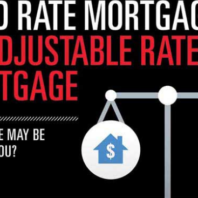Fixed vs. Adjustable Rate Mortgages
unitedfinancialfreedom October 8, 2021The dominant and most popular interest rates used when considering a mortgage are fixed rate and variable rate mortgages (also known as ARMs or variable rate mortgages). Deciding which type of interest rate is right for you should be based on personal criteria and what you want to achieve with your monthly payments.
Variable rate mortgages are loans in which a borrower pays an interest rate on the loan amount that changes based on specific rates chosen by the lender. Lower monthly payments are offered initially, then the monthly payment can be higher or lower depending on the index interest rate at that time. The adjustment period, or the period between the interest rate change, can be decided between you and the lender. However, adjustable rates often change based on a period of six months, one year, three years, five years, or even seven years.
Variable rate mortgages are a good option for those who can fill the following positions. You should choose an adjustable mortgage rate if there are unpredictable interest rates, which make it difficult to get a fixed rate, or if you are willing to take the risk of the interest rate rising and you are rewarded with an initially lower rate. The person who chooses this type of rate should realize that interest rates change frequently and if they increase, your payment may be higher than the original rate dictated and it may be lower if the interest rate falls.
It is important to prepare for these potential market developments so that a significantly higher or lower monthly payment after the adjustment period does not have any impact, positive or negative, on your personal finances.
So how do you exactly determine this Fixed vs. Adjustable Rate Mortgages? The original interest rate can be chosen based on a publicly published financial index or index, such as national or regional cash values or average costs of funds from savings and loan partners. . Then a margin is added to the index which determines the interest rate. The margin is generally the profit of the lenders above the financial index.
If the original interest rate is offered at an extremely low rate, then the lender may offer you a reduced rate, which temporarily keeps your monthly payments low for a specific introductory period and then changes based on the index rate and the adjustment period.
When considering a variable rate mortgage, it is important to compare the terms, which may include, the index used to determine the rate, the initial modification limit, the periodic limit, the lifetime limit, what is the margin and whether the spread is variable or constant over the term of the loan and whether you have the option of converting your loan to a fixed rate loan in the future.
Ceilings are limits set on loan interest rates. They are always available to the borrower and are expressed as follows: 2/2/5. The first number is the initial change limit, which is the limit set on the interest rate for the first adjustment period. The second number is the periodic limit, which is the limit set on the interest rate for each subsequent adjustment period. And the third number is the lifetime limit, or the total limit set on the rate for the term of the loan. It is often set at 6% for the first mortgage, but it can vary depending on the loan. Of course, the lower the numbers, the better for the borrower. Always be sure to request this information from the lender so that you can make an informed decision as to whether the specific adjustable loan will work for your financial situation.
A fixed rate mortgage is a loan where the interest rate stays the same for the life of the loan. The initial interest rate is usually higher than an adjustable rate, but it produces stable monthly payments. A fixed rate mortgage is good for those who always want to have the same monthly payment and don’t want to risk having a higher monthly payment or benefit from a lower monthly payment which can produce an adjustable rate.
When considering a fixed rate loan, it is important to take into account terms which may include interest rates, monthly payments, and fees. A fixed rate loan is simpler than a variable rate loan, but you still need to consider the interest rate, margin and any fees or points you have to pay the lender in exchange for borrowing the amount. of the loan. Always educate yourself about fees and points as they may not be clearly described or stated when considering a loan for the first time.



